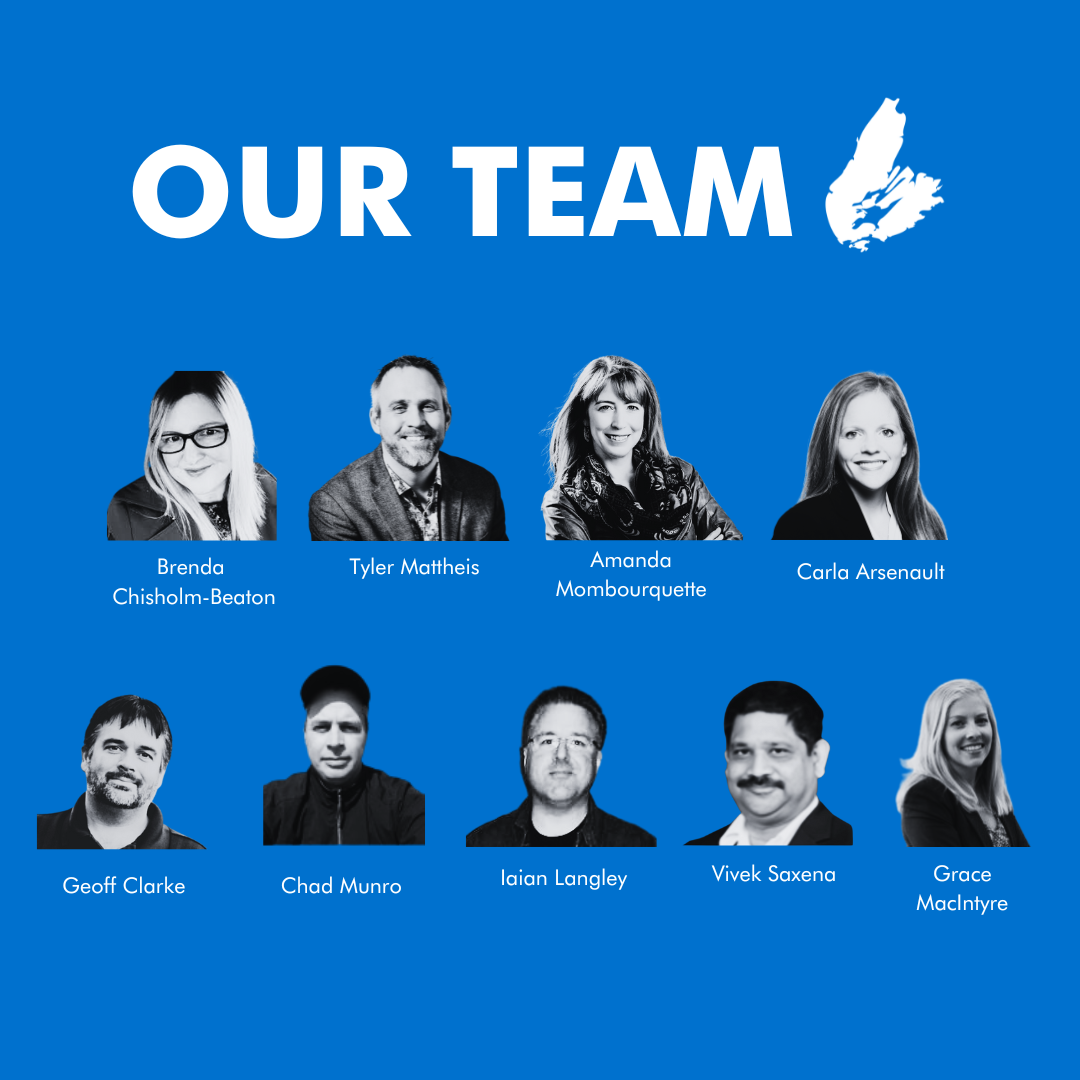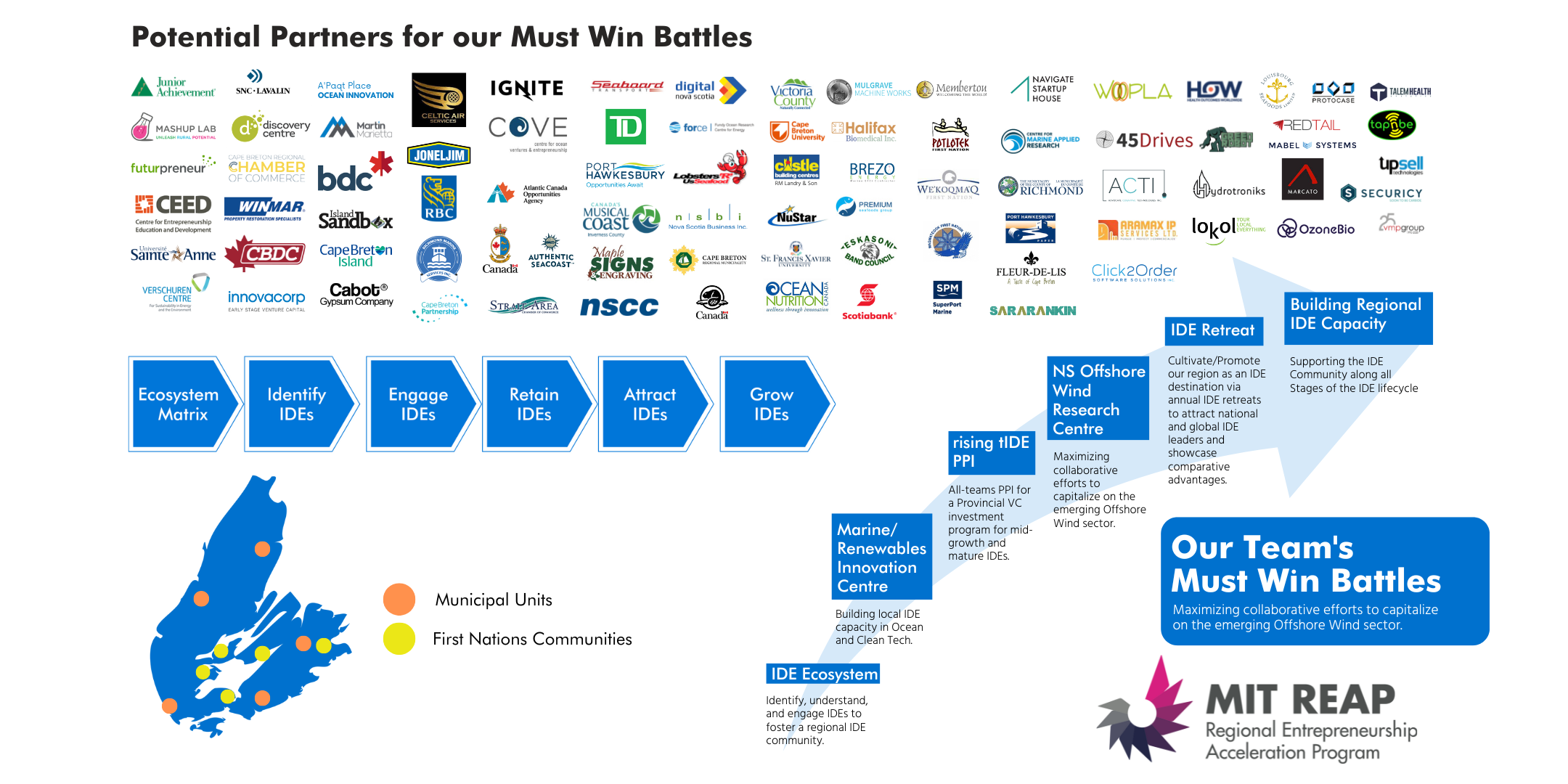MIT REAP Focus Nova Scotia
Cape Breton Strait Team
The southern part of Cape Breton – Unama’ki is known as the Strait Area. The region is named for its close proximity to the Strait of Canso, which separates mainland Nova Scotia from Cape Breton Island.
The Strait of Canso is a long thin channel, approximately 27 kms long, and 3kms wide. It has been remarked as one of the finest natural ice-free, deep-water ports on the eastern seaboard of North America, and has recently been named as a world-class resource in wind generation.
Here you will find information about Team Cape Breton Strait’s MIT REAP journey, and how a plan was created to break down the barriers to Innovation-Driven Entrepreneurship (IDE) development in the region.
As the team progressed on its journey, it became apparent that there was a much larger IDE ecosystem than originally thought. This led the team to make the decision to broaden their work and perspective to focus Island-wide, and be inclusive of partners across the Canso Causeway, such as the neighbouring Paqtnkek Mi’kmaw Nation and the Municipalities of the Counties of Antigonish and Guysborough.
Current Team:
Government
Brenda Chisholm-Beaton
Team Champion and Mayor of the Town of Port Hawkesbury
Tyler Mattheis
Project Manager and President & CEO of the Cape Breton Partnership
Captain Iaian Langley
Atlantic Pilotage Authority
Amanda Mombourquette
Community Innovation Lead at NSCC: Strait Area Campus and Warden of Richmond County
Corporate
Geoff Clarke
Port Hawkesbury Paper LP
Grace MacIntyre
SuperPort Marine Services
Tyler Mattheis
Project Manager and President & CEO of the Cape Breton Partnership
Education
Carla Arsenault
Principal at NSCC: Marconi Campus
Vivek Saxena
Principal at NSCC: Strait Area Campus
Amanda Mombourquette
Community Innovation Lead at NSCC: Strait Area Campus and Warden of Richmond County
Entrepreneur
Chad Munro
Halifax Biomedical
The composition of the core team changed with a few members departing, and a few joining at various stages of the program. We would like to thank and acknowledge the following original core members who have contributed to this process.
Original Core Team:
Roderick Googoo, We’koqma’q
Stakeholder Group: We’koqma’q First Nation
Allen Eddy, Port Hawkesbury Paper
Stakeholder Group: Corporate
Blaire Martell, Entrepreneur
Stakeholder Group: Entrepreneur/ Venture Capitalist
Bob Eachern, Entrepreneur
Stakeholder Group: Entrepreneur
Jim Kehoe, Entrepreneur
Stakeholder Group: Entrepreneur/ Venture Capitalist
Edgar Samson, Premium Seafoods
Stakeholder Group: Entrepreneur/ Venture Capitalist
Local Strategy
Throughout the 24-month journey, the team was able to identify four Must-Win-Battles to help the region overcome its barriers to innovation development. The team also wanted to pay tribute to the long-standing role innovation has played historically on the Island, and build on it.
The Must-Win-Battles include: developing programing and operations at Apaq’t Place/ Ocean Innovation Centre in the Town of Port Hawkesbury to serve IDEs in the Offshore Wind industry, hosting an innovators retreat, and taking steps to develop a Rising tIDE fund that will help address the regional gap in venture capital for innovation.
Here are some of the key activities the team completed over the course of the program to inform the future of the IDE landscape on Cape Breton – Unama’ki.
Local Strategy Must-Wins
-
The REAP team set out to determine the state of IDE activity in the region, and the results of the exercise did conclude there was a thriving innovation sector in the Cape Breton Strait region, and that discipline segmentation was occurring, with representation from information technology, advanced manufacturing, marine, cleantech-greentech, and medtech-biotech sectors.
Regional IDE Directory:
To help build a Regional Innovation-Driven Entrepreneurship (IDE) Directory, the team enlisted the expertise of Shawn Green from VMP Group to help identify how many startups reside on the Island and where they are located. This project uncovered that the voice of rural IDEs have largely been missing for some time in the region, particularly as it relates to considerations for policies and programs. To help address this, the creation of a regional
IDE contact database was created as a tool to achieve the following:
Better understand the history and mix of IDEs operating in the region,
Identify IDE trends, sectors, and industry clusters, and
Discover opportunities for improved outreach and communication with regional IDEs.
-
The team recognized that to build IDE capacity in the Cape Breton Strait region, there is a need to have a physical location that serves as an Innovation hub for IDE and Subject Matter Experts (SMEs), and entrepreneurs where they can access on-site or satellite programming/services to assist with their research, product development, or testing. Creating this workspace will also provide those working in the space and industry with a collision space to collaborate with other IDE and SME entrepreneurs.
Some milestones that have been reached to date are:
A’paqt Place - Mi’kmaq word for “ocean” - was chosen to reflect a desire to forge a strong relationship with this innovation space and First Nation stakeholders, and to ensure that the concept of “two-eyed seeing” continues as one of the guiding principles of the design and programming of the innovation space.
An initial focus group session held with First Nations, post-secondary, Municipal, venture capital, corporate, entrepreneurs, and innovation stakeholders at the Strait of Canso Yacht Club in 2019, with a site visit to the “Creamery” Building, now known as A’paqt Place/ Ocean Innovation Centre.
A’paqt Place received an infusion of $1 Million in renovations, and Nova Scotia Community College Nautical Institute has become an anchor tenant.
-
The Rising tIDE fund is an opportunity for the Province of Nova Scotia to grow an Innovation Ecosystem with private investors, entrepreneurship and other stakeholders. The Province as a limited partner with private equity can fill the regional gap in venture capital to grow Nova Scotia based innovation-driven enterprises.
IDE Focus Sessions / Retreats
Using the Quality Function Deployment (QFD) model, deeper ongoing engagement with regional IDEs represents a critical step in ensuring that a supportive IDE community is created and maintained. An annual retreat, focus session, or series of similar engagement activities has been identified as an important exercise in supporting this model.
-
Building on Offshore Wind as an emerging sector, the team identified the need for an Offshore Wind Research Centre for Nova Scotia. Step one will be to create a Business Plan to establish the Centre in the Cape Breton Strait region. This is a necessary step to attract and support rural IDEs seeking to capitalize on the region's combination of wind resources, and abundant comparative advantages. The establishment of a physical research centre in the newly created A'paqt Place/Marine Innovation Centre will help the industry grow while using the ample supply of industrial and waterfront space and infrastructure throughout the Strait of Canso.
Strait of Canso Offshore Wind Taskforce
In Nova Scotia, Offshore Wind is being pursued as a renewable resource capable of producing green energy at the scale required to meet market demands, while helping reduce Canada’s carbon footprint. The Strait of Canso Offshore Wind Taskforce was formed to help ready the region and its stakeholders for an emerging industry by working alongside industry partners and experts to ensure the responsible, sustainable, and inclusive development of the offshore wind industry across the province.
The work of the Task Force aligns with the Government of Canada's Federal Sustainable Development Strategy 2022-2026 and Canada's 2030 Emissions Reduction Plan. Development of five-gigawatts of offshore wind in Nova Scotia by 2030 will be the starting point to increase access to clean energy for Canadians, reduce GHG emissions, and create clean fuel exports to stimulate economic growth and provide Canada's international partners with reliable and secure energy.


